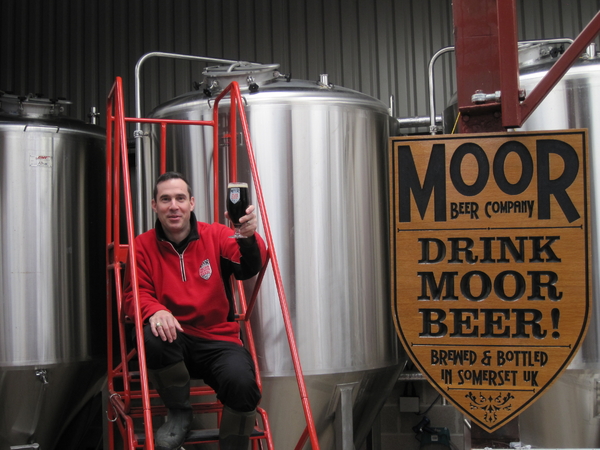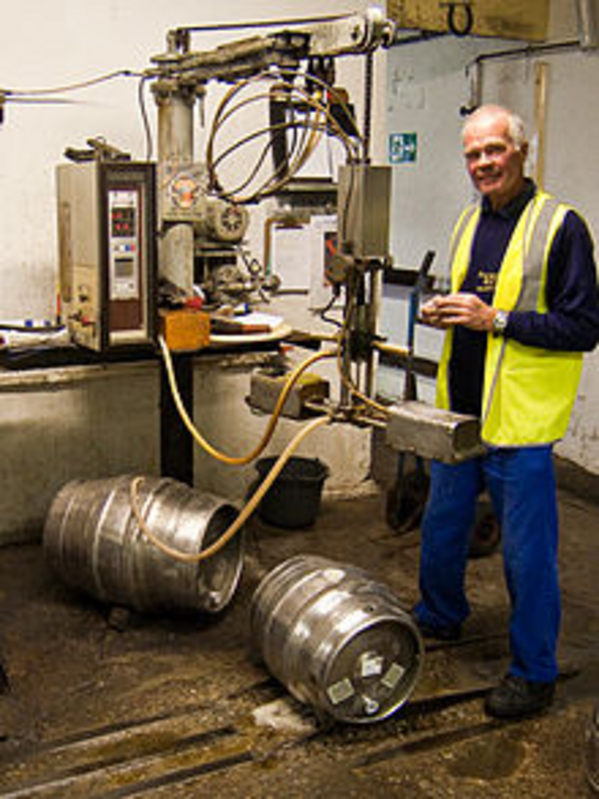Seeking clarity on cloudy beer
Added: Saturday, November 16th 2013

When one of the world’s preeminent beer writers invites you to pen an article on your most passionate subject, the obvious thing to do is sit on it for six months! It was not my intention to leave it this long, but I could never find enough time to sit down and collect my thoughts. As a brewer that produces only naturally hazy beers you’d think we’d have nothing but time on our hands, or would have shut the doors by now. I’m pleased to report quite the opposite, and hopefully you’ll understand why if you’ll allow me to educate and entertain you for a few moments.
As an industry -- brewers, publicans, retailers -- and passionate interest community -- drinkers, bloggers, writers -- that should be united, we find an awful lot of things to argue about internally: “craft”, keg, styles, tradition, clarity, and other emotive topics. These arguments are equally amusing and frustrating. “Can’t we all just get along?” springs to mind. Beer camps are very tribal. We are all so passionate about beer, to the point of religious fervour. History is littered with numerous examples of religious fervour leading to division and outright war. Hopefully we can all learn from the past and rejoice on our common ground, learning to tolerate, if not love, the broad world that is beer – hazy or otherwise.
My journey around this beer world started at a very young age. My Dad enjoyed sampling different beers, which in 1970s California meant imports, Anchor, and Sierra Nevada a few years later. He was never a volume drinker, just someone who enjoyed flavour, history and artwork. He would hunt down bottles from far- flung locales and allow me to have a taste when he found something new. He started travelling to Britain for business in the 80s and I was fortunate enough to join him on one trip, which is how I fell in love with British pubs and real ale.
Graduating from West Point in the early 90s, I had the good fortune to be posted to Germany during an interwar period. That meant lots of time to beer hunt on the continent! When we weren’t at our local brewpub, my wife and I were driving around Germany, Belgium and Czechoslovakia enjoying the sights and brews at every opportunity. It gave me a great grounding in global beer styles and taught me that the world of beer is vast and amazingly diverse. In all these travels the one thing that was a consistent subliminal truth was clarity, or actually lack thereof. German brewpub beers were all cloudy -- not just the wheats!. They were also the freshest, most aromatic and boldly flavoured. They were easier drinking, more textured, and left you feeling better the next day. Belgian and Czech beers were no different. I didn’t quite understand why at the time.

When we left Germany we returned to California just as the micro-brewing revolution was kicking off. It was there that I learned to brew, and also got my hop addiction. Not surprisingly, the universal truth followed me to Cali – hazy beers were the best. Bold, brash, uncompromising. You knew how good your IPA was going to be by how hazy it was. A clear beer was good for one, then you moved on looking for something better. The properly hazy beer was a sight to behold, and you sessioned on it until you reluctantly returned home. But that universal truth was still subliminal. No one in any of the countries I spent time in was concerned at all about clarity. It was just how things were. People didn’t hold a beer up to the light and send it back for being hazy. I would love to have seen someone try that in Germany!
But as good as the beer was on my travels, I couldn’t shake the quintessential British pub, so found a way to move here. Within days of landing we drove to St. Albans and joined CAMRA, and weeks later I was volunteering at my first Great British Beer Festival. Life was great. Then the honeymoon period ended and I realised readily available beers were of one style, and all were lacking the vibrancy and depth I had become accustomed to. It was always my intention to open our brewery in Britain, and the first thing I wanted to do was introduce other beer styles. But of course no one would buy my beer if it was cloudy, so I fined my beers like everyone else.
The beer I kept for sampling and QA (tough job!) was left unfined. It was always better than the way it was served in pubs. That’s not a dig at landlords; the beer itself was physically different. Finally the penny dropped – the finings (seen added in picture above) were stripping my beer of flavour. It was then that I started to move away from using finings, slowly at first as this was a very brave new world. Dark ones were the easiest to leave unfined as no one really notices anyway. Strong beers were next, then hop forward ones, and finally everything.
My courage to make the transition was bolstered by some great experiences. First was the Queen’s Arms in Corton Denham. The then manager James Scrancher shared my enthusiasm for flavour and was convinced he could make it work in his pub. And did he ever! Within a very short period of time our hazy beers deposed two well loved regional beers from the bar – and volumes went up! Our beer was visibly different, richer in every way, and people flocked to it. Of course there will always be the odd die hard that prefers clear beer, but the problem was actually not with the consumer. To this day it still gives me great pleasure to walk into that pub and see locals of all (legal drinking) ages enjoying our cloudy beer. And more than a few foreigners have travelled there specifically for the experience. Great beer makes great business.

The next sign that we were on to something was a CAMRA coup. Our local Somerset branch was holding the annual Minehead Beer Festival. The branch members decided to challenge us by having a fined and unfined cask of the same beer at the festival for people to compare. And, by popular vote, the unfined version was voted champion of the festival, out of more than 100 beers. The beers were like night and day, driving another nail in the finings coffin.
The final sign was when national pub chain Mitchells & Butler decided to take a punt on our unfined beers, and kept rotating through them for many quarters. This proved that unfined beer has wider appeal in the UK. It is not just for aficionados. But it does take a small amount of education, both to and from the bar staff. Nearly every consumer could care less about clarity. It’s just that it’s been drilled into them for decades, so with some more seasoned drinkers it can take a bit of convincing. And let’s face it, not everyone will be convinced. Newer beer drinkers much prefer unfined beer as they can see the goodness in their glass. And of course it’s vegan friendly so there is a whole new market out there waiting for just this concept.
Once we made the transition we felt it was important to pave the way for other like-minded brewers. We proposed a motion at the SIBA (Society of Independent Brewers) annual meeting to remove beer clarity from competition rules. For those not involved in competitions, this is a major mind shift as hazy beers, intentional or not, were automatically disqualified from competitions. Our motion was unanimously approved – a huge surprise. No surprise though that the first festivals to enact the rules saw us win regional and national awards for our unfined beers. As the community started to grow, we put a whole section on our website devoted to educating people about unfined beers (http://moorbeer.co.uk/unfined-natural-beer/ ), and even include a list of brewers who produce them, along with a link to their sites. There have been unfined-only events and festivals organised recently, and not by us (although of course we support them).
But the journey is not over. In my evangelism I made one simple yet important error when creating a classification of “unfined” beer. It introduced a level of unnecessary technicality to an otherwise unconcerned audience. I have grown to use the term “natural” beer, as the beer is more natural and is meant to be naturally hazy. Semantics aside, what are finings and why are they detrimental to your beer?
Finings are anything added to your beer that helps remove haze-forming particles. These could be yeast, protein, oils, polyphenols, herbs, spices, hops, fruit, coffee, etc. We could add bacteria to the list (the reason cloudy beer got a bad name in the UK in the first place). After all, it was the slow sale of (real) ale decades ago and the resultant long duration in unclean lines that led people to incorrectly link haze with spoilage. Thankfully it is much rarer now to find poorly brewed or kept beer. For our purposes I’m assuming clean brewing and cellar practices.
There are various finings for various things. From a brewing perspective the ones used work on protein, polyphenols and yeast. The best fining agents are time and temperature control, as most beer styles will clear naturally if left long enough at the right temperatures in clean, oxygen-free environments. This is where the knowledge, experience and attention to detail of clean brewers come to the fore. For those of us brewing “real” ale (conditioned in the container – cask, keg or bottle – with live yeast) we pass our babies on to the cellar person to manage, yeast and all. And in a modern cellar (and with modern beer styles) the cellar person does not have the time to leave beers long enough to clear naturally. So in a well-intentioned but disastrous attempt to clear beer quicker, isinglass finings are employed.
Isinglass finings (pictured above) are an acidified, aqueous solution produced from the swim bladder of fish and preserved with sulphur dioxide. They work by electrically attracting yeast, forming large clumps, and letting gravity pull them to the bottom. In the process they also drag down other flavour active particles such as hop oils. Yes, there are fish guts, acid, and sulphur dioxide added to most real ale sold in the UK, all with the purpose of shortening the time it takes them to drop bright. Enjoy!
But we want some of those haze forming particles in our beer. They add texture, visual impact, aroma and flavour. Plus you can never fully guarantee that you’re not drinking isinglass finings when served a pint of beer. All those legends about the end of a barrel giving you bad guts were actually from people consuming finings. In fact, brewers’ yeast (the main haze former in real ale) is sold as a health aid and is known to be good for digestion. And all those scrumptious hop oils we infuse in copious quantities are rich in antioxidants and other positive health agents (most importantly they smell and taste sublime!). Why remove them in favour of a clearer beer? People nowadays know that cloudy drinks are more satisfying. Just look at cloudy juice, cider, broths, etc. The same applies to naturally hazy beer unless you’ve been beaten like Pavlov’s dog to believe otherwise.
For the brewer, I’m sorry to say unfined beer will increase your cost. Isinglass is cheaper than beer, so by not bulking out your beer with additives you will marginally decrease your volumes, which is a very worthwhile price to pay for better beer. It will initially take a bit more effort to sell and educate your customers but you will develop better relationships with them. And you’ll stop getting bogus ullages for “hazy beer”!
For the cellar person, unfined beer will make your job easier as you are not waiting for a cask to drop gin bright, especially one that isn’t meant to anyway. This is by no means an excuse for shortening cellar techniques or serving sloppy beer. The perfect level of haze will be different for every beer and every person. When it smells and tastes great, it’s ready.
For the bar staff this will require a bit more selling and communicating on your part – initially. Don’t say you’re too busy. I’ve been in heaving pubs with great bar staff engaging meaningfully with drinkers thirsty for both beer and knowledge. You are helping create better customers and possibly lifelong friends. After that it will make your job easier as you won’t have pedants coming in and questioning whether your beer is gin bright versus nearly there.
For the landlord this will mean more money in the till. You will have less wastage, easier cellar management, and higher volumes. Unfined beer presents a visible, marketable point of difference. You can reach out to segments of society ignoring beer at the moment. And you will wow your customers with better beer and a richer experience.
And for the drinker, your life will be much better for it. Your beer will undoubtedly look more striking, you’ll be able to see the goodness in it, and it will undoubtedly feel, smell and taste richer. You may decide that you prefer your beer with less flavour and gin bright. That’s OK, as the majority of beer is still brewed and served that way. We’re not taking anything away from you. What we are offering is the opportunity to expand your horizons. You may be very pleasantly surprised!
Above all, enjoy beer. We can be overly serious about it at times, but try to remember it is there to add pleasure to our lives. The beer you enjoy, and the way you enjoy it, may be foul to the next drinker. Malty, hoppy, light, dark, sweet, bitter, sour, clear, hazy, flat, fizzy, cold, warm, flavoured, traditional, modern -- there is no right answer, just a world of variety to experience. Judge with your eyes if you must, just adjust your glasses.
*Justin Hawke runs Moor Beer Company in Pitney, Somerset.




